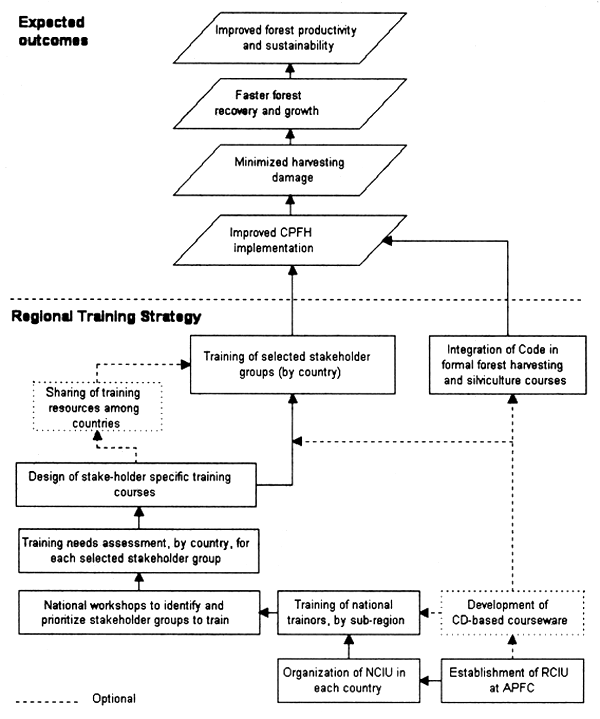The goal of the regional training strategy is to strengthen the capacity of Asia-Pacific countries to implement the Code of Practice for Forest Harvesting in Asia-Pacific effectively and to assist countries in the adoption of RIL practices. Achieving this goal is expected to reduce the negative impacts of harvesting operations in the forests significantly; this would greatly facilitate faster recovery and sustained productivity of forests where harvesting operations take place.
The training strategy has been developed to support the following objectives:
The regional training strategy uses three major tactics:
The adoption of these tactics requires the following activities:
The major outcome of the regional training strategy will be improved Code implementation and the application of RIL practices at the country level. Figure 2 shows the general framework of the strategy and its expected outcomes.

RCIU - Regional Coordinating and Implementing Unit
NCIU - National Coordinating and Implementing Unit
CPFH - Code of Practice for Forest Harvesting
Figure 2. The regional training strategy and its expected outcomes
The regional strategy will provide training to three main groups of potential Code trainees:
The target training groups may come from the public sector, private companies involved in forest harvesting operations, NGOs, forest-dependent communities and the media (Table 1).
| Groups or levels | Government sector | Private companies | Others |
|---|---|---|---|
| National trainers | √ | √ | |
| Key training target groups | |||
| Senior management, including policy-makers | √ | √ | |
| Middle management | √ | √ | |
| Front-line supervisors | √ | √ | |
| Fieldworkers/operators | √ | √ | |
| Other stakeholders | |||
| NGOs | √ | ||
| Opinion-makers | √ | ||
| Journalists | √ | ||
| Forest-dependent communities | √ |
The target groups are expected to vary from country to country because different countries have different needs. Moreover, priority groups to be trained will be selected by each country. Because there are likely to be funding constraints in many of the countries, prioritization of trainee groups at the country level is desirable.
While identifying priority stakeholders at the country level, it is advisable to disaggregate some of the groups into more or less homogenous subgroups. For instance, the fieldworkers/operators group can be broken down into chainsaw operators, tree markers, tree fellers, heavy equipment operators.
The courses of action needed to meet the objectives of the training strategy and expected outcomes are defined in Table 2.
| Objective | Action | Expected outcomes |
|---|---|---|
| • To identify and prioritize the groups of stakeholders in each country that require training. | • Organization of national workshops | • List of stakeholders. |
| • Shortlist of priority stakeholder groups that should be trained. | ||
| • List of country institutions or organizations with qualified personnel to train the priority trainee groups. | ||
| • List of potential sources of funds for the training courses to be organized. | ||
| • Lists of major topics to be included in training the different trainee groups, as baseline information for the TNA to be conducted later. | ||
| • Potential venues for training. | ||
| • To improve the capacity of countries to design and organize courses. | • Organization of a course for national trainers to be conducted at the subregional level. | National trainers with enhanced skills in: |
| • Conducting TNAs. | ||
| • Designing, organizing and coordinating short courses. | ||
| • Preparing teaching aids. | ||
| • Teaching short courses. | ||
| • To develop CD- based materials for teaching different stakeholder groups in each country. | • Commissioning of a group to design and develop the tutorial. | • A CD containing training modules for different stakeholder groups. |
| • To develop and organize in-country training courses for priority stakeholder groups. | • TNA of the priority stakeholder groups by the national trainers. | • Lists of topics to be included in the courses to be developed for the different priority stakeholder groups. |
| • Design and development of the training courses for each priority stakeholder group by the national trainers. | • Course plans for each stakeholder group. | |
| • Implementation of training courses. | • Stakeholders with improved skills in Code implementation. | |
| • To promote the sharing of training resources among the different countries to improve the cost- effectiveness of the in-country courses. | • Establishment of a unit within the APFC that will serve as a repository of and distribution centre for Code-related training materials developed by the different countries. | • Collection of training materials that can be used by the different countries involved in training. |
| • To promote the use of codes as instructional material in universities and colleges that offer formal or informal courses in forest harvesting. | • Holding of meetings with concerned university or college officials to distribute copies of the Code and to discuss the possible use of the Code as training material for forest harvesting courses. | • Increased use of the Code as training material for forest harvesting courses in universities and colleges. |
An important feature of the regional training strategy is that trainers will be trained at the regional or subregional level while implementers will be trained at the country level. It is expected that the total number of in-country courses to be organized will be many times greater than the number of courses to be held at the subregional level. Assuming, for instance, an average of only two courses per country, the total number of in-country courses would be 40 for 20 countries.
The strategy, which emphasizes in-country training, has several advantages. The most important ones are: